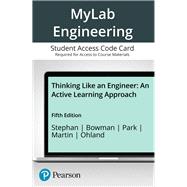For first-year engineering courses.
This ISBN is for the MyLab access card. Pearson eText is included.
Thinking Like an Engineer is designed to facilitate an active learning environment for first-year engineering courses. Checkpoints in each chapter provide worked-out problem sets for you to solve using your own logic, helping you develop the problem-solving skills you need to solve more difficult problems. A variety of collaborative problem-solving activities, computer-based activities, and hands-on experiments help you take your learning further and develop the skill set to begin thinking like an engineer. The 5th Edition is updated to incorporate current software releases, including Microsoft® Office 2019®, Office 365®, Excel® Online, and MATLAB® 2020a.
Personalize learning with MyLab Engineering with Pearson eText
This flexible digital platform combines unrivaled content, online assessments, and customizable features to personalize learning and improve results. MyLab Engineering includes new, edition-specific automated assessment of MATLAB code submissions with real-time feedback and integration within the MyLab Engineering gradebook — giving you more opportunities to practice essential coding skills.
Pearson eText is an easy-to-use digital textbook available within MyLab that lets you read, highlight, and take notes, all in one place.
NOTE: Before purchasing, check with your instructor to confirm the correct ISBN. Several versions of the MyLab® and Mastering® platforms exist for each title, and registrations are not transferable. To register for and use MyLab or Mastering, you may also need a Course ID, which your instructor will provide.
Used books, rentals, and purchases made outside of Pearson
If purchasing or renting from companies other than Pearson, the access codes for the MyLab platform may not be included, may be incorrect, or may be previously redeemed. Check with the seller before completing your purchase.











